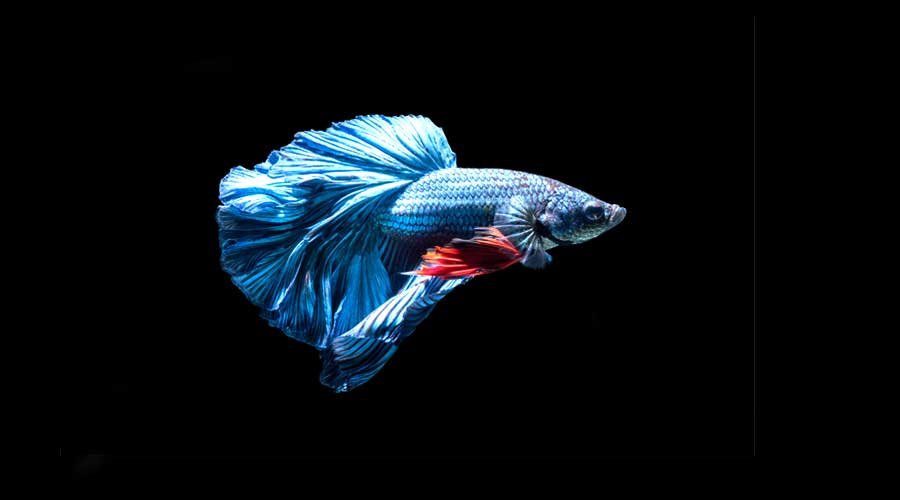Best 9 Tank Mates for betta fish and 5 Avoid
Betta fish are popular aquarium fish, favored by many people due to their attractive colors and calm temperament. It is important to choose a suitable tank mate for betta fish, as they are generally peaceful.
A suitable tank mate for betta should also be peaceful so as not to disturb them.
Based on my aquarium experience, here are some recommendations for betta mates that I hope will work well with your betta.
Best 9 Tank Mates for Betta Fish
1. Bronze Corydoras

bronze-corydoras
Species Overview
- Scientific name: Bronze Cory, Green Cory
- Common name: Corydoras aeneus
- Family: Callichthyidae
- Size: Its length is usually around 2.5 inches (6 centimeters).
- Behavior: Bronze Corydoras are peaceful, social, and gregarious fish. They prefer to live in small groups of 5-6.
- Color: The upper part of their body is brown or copper, and the lower part is lighter in color. In some cases, a greenish tinge can also be seen on their body.
- Origin: South America, including Colombia, Uruguay, and Argentina
- Lifespan: Their lifespan is usually 5 to 10 years.
Residence
Bronze Corydoras prefer to live in groups, and a 20-gallon tank is suitable for keeping a small group of 5-6 Corydoras. However, if more fish are kept or other species are added, the tank size needs to be increased.
Some plants (such as Java Fern, Java Moss, Anubias, and Amazon Sword), caves, or rocks can be used for them, which act as safe hiding places.
Care of Bronze Corydoras
Water Conditions and Parameters: The ideal temperature for them is 22°C to 26°C (72°F to 79°F). Ideal pH: 6.0 to 7.8. The ideal water hardness is 2 to 12 degrees dGH. A 20-25% water change should be done every week to keep ammonia and nitrate levels under control.
Food Habits: Bronze Corydoras are omnivorous fish. They also like to eat extra food left at the bottom of the aquarium, which helps keep the tank clean.
Breeding
Breeding Bronze Corydoras is quite easy. Male and female fish differ slightly during the breeding season. For spawning, the water temperature should be reduced slightly, and fresh water should be provided.
Females lay 50-100 eggs at a time, which are usually attached to plant leaves or moss-like substrates. The eggs hatch in 3-5 days.
Suitable Partners
Bronze Corydoras are peaceful and sociable fish that get along easily with other peaceful fish and animals. To select a suitable partner for them, one should choose peaceful, small to medium-sized fish and animals.
Suitable companions include Neon Tetra, Cardinal Tetra, Molly, Cherry Barb, and Amano Shrimp.
2. Otocinclus Catfish
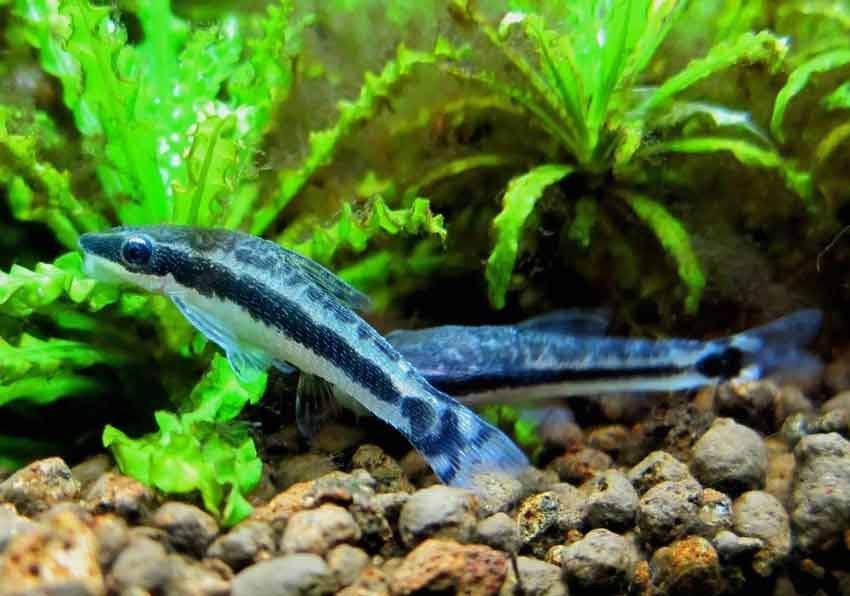
Otocinclus Catfish
Species Overview
- Scientific Name: Otocinclus vittatus
- Common Names: Otocinclus, Oto Catfish, Dwarf Sucker, Oto
- Family: Loricariidae
- Size: About 2–4 cm (up to 1.5 inches)
- Color: Body color is usually light brown or greenish, with black or dark brown stripes along the body.
- Origin: Riverine regions of South America, especially Brazil, Peru, and Colombia.
- Lifespan: Usually 3–5 years
Residence
Typically, 20 liters of water is needed for every 2 to 3 Otocinclus catfish. However, they will grow better in larger tanks. Caves, rocks, and suitable plants (Java Fern, Anubias, Aquatic Grass, Moss) should be kept to maintain the environment of Otocinclus catfish.
Care of Otocinclus Catfish
Water Conditions and Parameters: 22 to 28 degrees Celsius (72 to 82 degrees F), pH 6.5 to 7.5, hardness 2 to 15 degrees (dGH), and ammonia and nitrite should be kept at 0 ppm. Moreover, 20-30% of the water should be changed every week to maintain water quality.
Diet: Otocinclus catfish are omnivorous but prefer to eat algae. They can also eat aquatic plants, flake food, and frozen food.
Breeding
Fish should be healthy and active before breeding. The female fish usually lays 50 to 200 eggs, which are attached to plant leaves or tank walls. The eggs usually hatch in 2 to 7 days. During this time, the male fish takes care of the eggs and keeps the algae clean.
Suitable Partners
Otocinclus catfish are peaceful fish that can coexist peacefully with other calm-loving fish (Tetras, Platies, Guppies, Danios). Aggressive fish or animals should not be kept with them.
3. Zebra Nerite Snail

zebra-nerite-snail
Species Overview
- Size and Color: Zebra nerite snails are about 1 to 1.5 inches long. Their shells are decorated with yellow-black stripes, which look like zebras, hence the name “zebra nerite.”
- Lifespan: Zebra nerite snails usually live for 1 to 2 years. However, they can live up to 3 years if given proper care and a suitable environment.
- Water Type: They generally survive well in freshwater but require saltwater for breeding.
- Behavior: The zebra nerite is extremely peaceful. They do not cause any problems with other fish or snails.
Zebra Nerite Snail Care
- Water and Environment: A water temperature of 72-78°F (22-26°C), a pH of 7.0 to 8.5, and a carbonate hardness of 6-12 dKH are best for zebra nerite snails.
- Food: They mainly feed on algae in the tank, but marketed snail food can be provided if required. In addition, they eat small pieces of vegetables, such as cucumbers or zucchini.
- Shell Pests: They are very sensitive to shell damage, which can be a serious problem for snails. Sufficient calcium is required for shell formation, so the water should have adequate calcium to support this process.
Breeding
If there is a male and female, they lay eggs in freshwater, but hatching requires seawater. Therefore, they do not breed easily in home aquariums. However, if you have a household water softener, the sodium content of your water may affect egg hatching.
Suitability as a Partner
- Suitable Companions: Zebra nerite snails are peaceful, so their suitable companions are peaceful and non-aggressive fish. For example, tetra fish, mollies, guppies, cherry barbs, and danios.
- Unsuitable Companions: Fish or animals that may attack or eat snails should be avoided as companions, such as puffer fish, cichlids, goldfish, crabs, and aggressive snails.
4. Kuhli Loach(Pangiokuhlii)
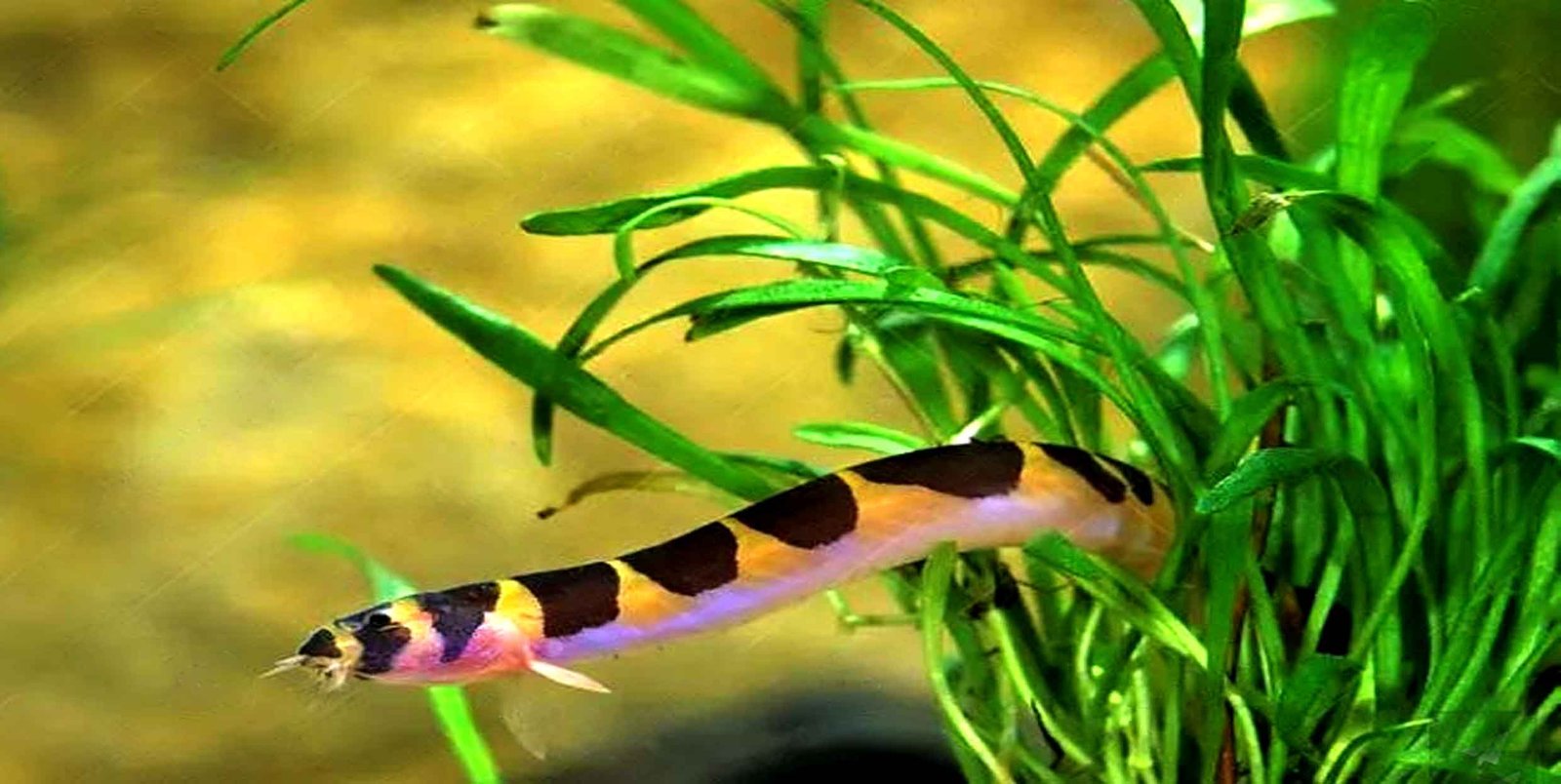
Kuhli Loach (Pangiokuhlii)
Species Overview
Scientific name: Pangio kuhlii
Common name: Kuhli Loach, Coolie Loach, Leopard Loach
Family: Cobitidae
Size: 7–10 cm (3–4 inches)
Behavior: Nocturnal, peaceful, and shy. They are social and prefer to be in groups of 3 or more. They often hide during the day and become active at night.
Color: Pinkish or yellowish body with dark brown or black vertical stripes.
Origin: Southeast Asia (Indonesia, Malaysia, Thailand).
Lifespan: 10–14 years in optimal conditions.
Residence: Slow-moving streams, rivers, and floodplains with sandy or muddy bottoms and dense vegetation.
Water Conditions and Parameters:
- Temperature: 24–30°C (75–86°F)
- pH: 5.5–7.0 (slightly acidic to neutral)
- Hardness: Soft to moderately hard water (1–10 dGH)
- Filtration: Clean, well-filtered water with a gentle flow.
Food Habits: Omnivorous. They eat small live or frozen foods (e.g., bloodworms, brine shrimp), sinking pellets, and algae. They also scavenge for leftover food.
Breeding:
- Breeding in captivity is rare and challenging.
- Requires soft, acidic water and a well-planted tank.
- Eggs are laid among fine-leaved plants or roots and hatch in about 24 hours.
Suitable Partners:
- Peaceful, similarly sized fish like:
- Tetras (e.g., Neon Tetras, Ember Tetras)
- Rasboras
- Corydoras Catfish
- Dwarf Gouramis
- Small Barbs
- Shrimp (e.g., Cherry Shrimp)
- Avoid aggressive or large fish that may stress or harm them.
Kuhli Loaches are fascinating and unique additions to community tanks, known for their eel-like appearance and playful behavior. They thrive in well-planted tanks with plenty of hiding spots like caves, driftwood, and smooth rocks.
5. Guppy Fish
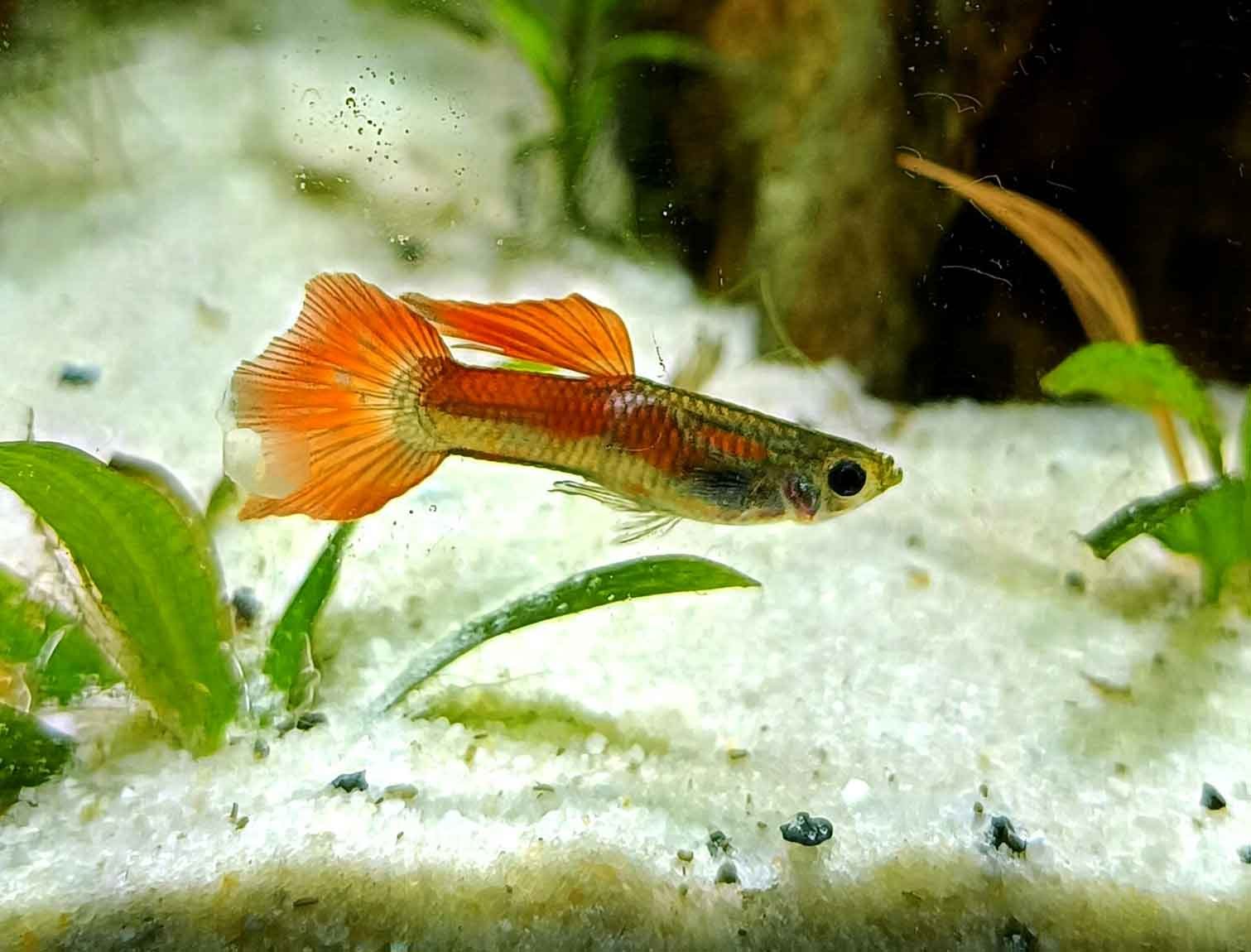
Guppy Fish
Species Overview
Scientific name: Poecilia reticulata
Common name: Guppy, Millionfish, Rainbow Fish
Family: Poeciliidae
Size: 2–6 cm (0.8–2.4 inches)
Behavior: Peaceful, active, and social. They are highly adaptable and thrive in groups. Males may display mild territorial behavior.
Color: Highly variable, with males displaying vibrant colors and patterns (e.g., red, blue, yellow, orange) and females being less colorful, often silver or gray.
Origin: Northeast South America (Brazil, Guyana, Trinidad, and Tobago).
Lifespan: 2–3 years in optimal conditions.
Residence: Freshwater streams, ponds, and shallow waters with vegetation.
Water Conditions and Parameters:
- Temperature: 22–28°C (72–82°F)
- pH: 6.8–7.8 (neutral to slightly alkaline)
- Hardness: Moderate to hard water (8–12 dGH)
- Filtration: Clean, well-filtered water with moderate flow.
Food Habits: Omnivorous. They eat flake food, pellets, live or frozen foods (e.g., brine shrimp, daphnia), and vegetable matter.
Breeding:
- Livebearers (give birth to free-swimming fry instead of laying eggs).
- Females can store sperm and produce multiple broods from a single mating.
- Gestation period: 21–30 days.
- Provide hiding spots (e.g., plants) for fry to avoid being eaten by adults.
Suitable Partners:
- Peaceful, similarly sized fish like:
- Platies
- Mollies
- Swordtails
- Tetras (e.g., Neon Tetras)
- Corydoras Catfish
- Rasboras
- Avoid aggressive or fin-nipping fish like Tiger Barbs or large cichlids.
6. Molly
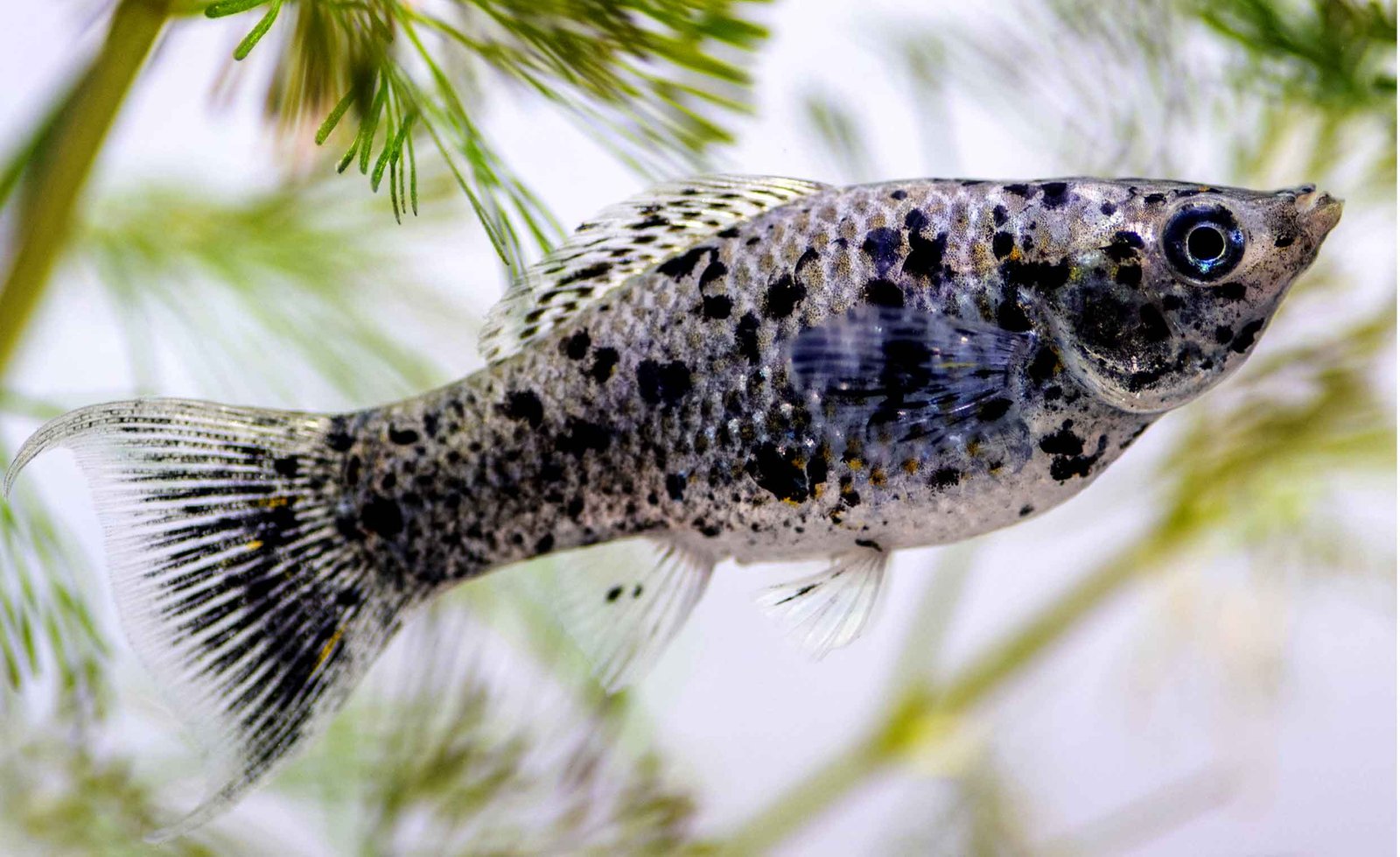
Molly
Species Overview
Scientific name: Poecilia sphenops (and other Poecilia species)
Common name: Molly
Family: Poeciliidae
Size: 6–12 cm (2.5–4.7 inches)
Behavior: Peaceful, active, and social. They are hardy and adapt well to community tanks.
Color: Varied, including black, white, gold, orange, and spotted or marbled patterns.
Origin: Central and South America (Mexico, Colombia, Venezuela).
Lifespan: 3–5 years in optimal conditions.
Residence: Freshwater and brackish waters, including rivers, streams, and coastal areas.
Water Conditions and Parameters:
- Temperature: 22–28°C (72–82°F)
- pH: 7.5–8.5 (slightly alkaline)
- Hardness: Moderate to hard water (10–25 dGH)
- Filtration: Clean, well-filtered water with moderate flow.
Food Habits: Omnivorous. They eat flake food, pellets, live or frozen foods (e.g., brine shrimp, bloodworms), and vegetable matter.
Breeding:
- Livebearers (give birth to free-swimming fry instead of laying eggs).
- Females can store sperm and produce multiple broods from a single mating.
- Gestation period: 6–10 weeks.
- Provide hiding spots (e.g., plants) for fry to avoid being eaten by adults.
Suitable Partners:
- Peaceful, similarly sized fish like:
- Guppies
- Platies
- Swordtails
- Tetras (e.g., Neon Tetras)
- Corydoras Catfish
- Rasboras
- Avoid aggressive or fin-nipping fish like Tiger Barbs or large cichlids.
7. Gold Wagtail Platy

Gold Wagtail Platy
Species Overview
Scientific name: Xiphophorus maculatus
Common name: Gold Wagtail Platy
Family: Poeciliidae
Size: 4–6 cm (1.5–2.5 inches)
Behavior: Peaceful, active, and social. They thrive in groups and are great for community tanks.
Color: Golden body with a black “wagtail” (caudal fin) and often black accents on other fins.
Origin: Central America (Mexico, Guatemala, Honduras).
Lifespan: 3–5 years in optimal conditions.
Residence: Freshwater rivers, streams, and warm, slow-moving waters with vegetation.
Water Conditions and Parameters:
- Temperature: 18–25°C (64–77°F)
- pH: 7.0–8.0 (neutral to slightly alkaline)
- Hardness: Moderate to hard water (10–28 dGH)
- Filtration: Clean, well-filtered water with moderate flow.
Food Habits: Omnivorous. They eat flake food, pellets, live or frozen foods (e.g., brine shrimp, bloodworms), and vegetable matter.
Breeding:
- Livebearers (give birth to free-swimming fry instead of laying eggs).
- Females can store sperm and produce multiple broods from a single mating.
- Gestation period: 4–6 weeks.
- Provide hiding spots (e.g., plants) for fry to avoid being eaten by adults.
Suitable Partners:
- Peaceful, similarly sized fish like:
- Guppies
- Mollies
- Swordtails
- Tetras (e.g., Neon Tetras)
- Corydoras Catfish
- Rasboras
- Avoid aggressive or fin-nipping fish like Tiger Barbs or large cichlids.
8. Dwarf Gourami
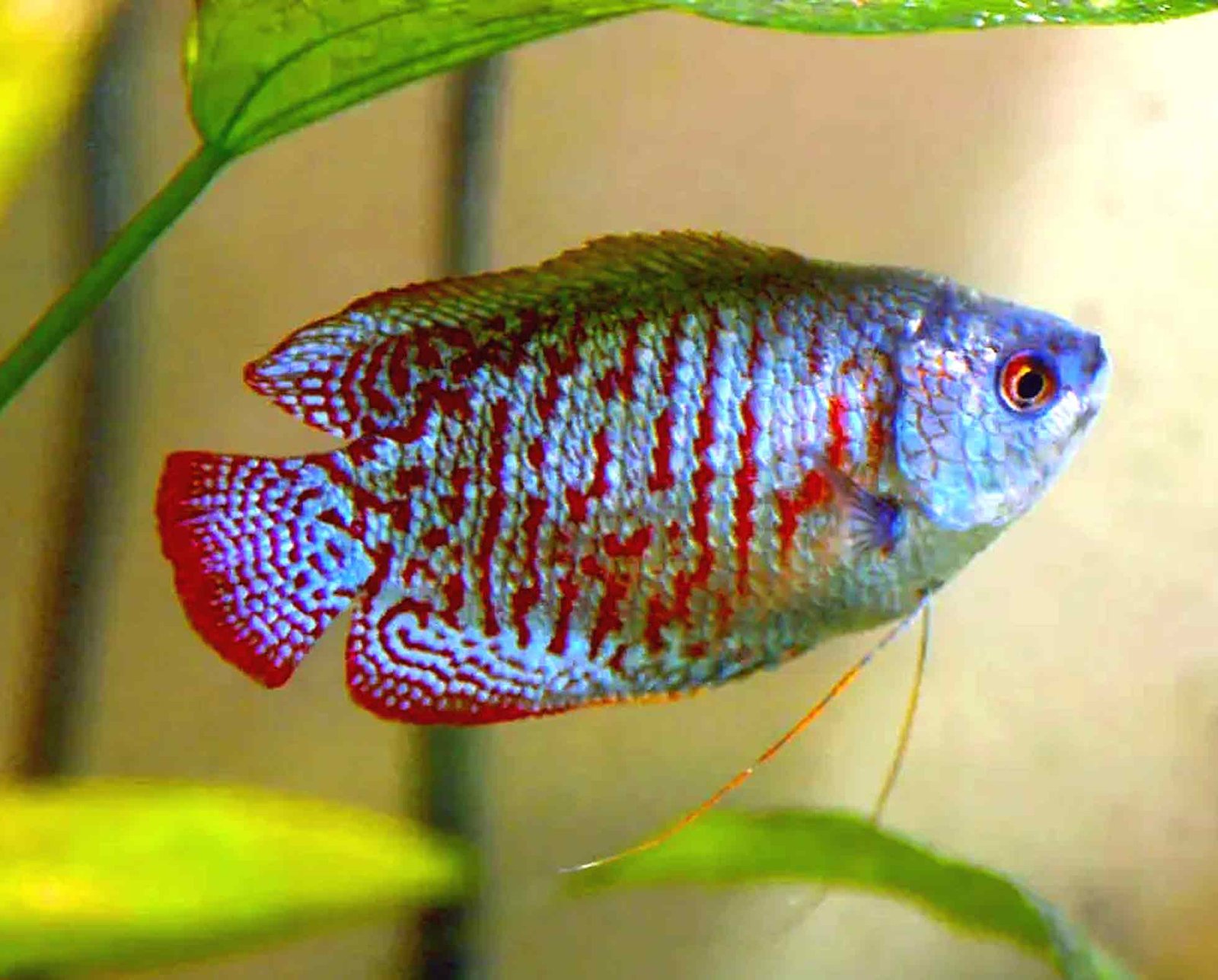
Dwarf Gourami
Species Overview
Scientific name: Trichogaster lalius
Common name: Dwarf Gourami, Red Gourami
Family: Osphronemidae
Size: 5–8 cm (2–3 inches)
Behavior: Generally peaceful but can be shy or territorial, especially males. They are labyrinth fish, meaning they can breathe air from the surface.
Color: Males are brightly colored with blue and red/orange stripes, while females are duller, usually silver or pale blue.
Origin: South Asia (India, Bangladesh, Pakistan).
Lifespan: 4–6 years in optimal conditions.
Residence: Slow-moving freshwater habitats like ponds, lakes, and rice paddies with dense vegetation.
Water Conditions and Parameters:
- Temperature: 22–28°C (72–82°F)
- pH: 6.0–7.5 (slightly acidic to neutral)
- Hardness: Soft to moderately hard water (5–15 dGH)
- Filtration: Clean, well-filtered water with minimal flow.
Food Habits: Omnivorous. They eat flake food, pellets, live or frozen foods (e.g., brine shrimp, bloodworms), and vegetable matter.
Breeding:
- Males build bubble nests at the water’s surface for breeding.
- After spawning, the male guards the eggs and fry. Females should be removed to prevent aggression.
- Eggs hatch in 24–36 hours, and fry becomes free-swimming after a few days.
Suitable Partners:
- Peaceful, similarly sized fish like:
- Neon Tetras
- Harlequin Rasboras
- Corydoras Catfish
- Small Tetras
- Guppies
- Mollies
- Avoid aggressive or fin-nipping fish like Tiger Barbs or larger cichlids.
9. Neon Tetra

neon-tetra
Species Overview
Scientific name: Paracheirodon innesi
Common name: Neon Tetra
Family: Characidae
Size: 1.5 to 2.5 cm (0.6 to 1 inch)
Behavior: Peaceful, schooling fish. They thrive in groups of 6 or more and are active swimmers.
Color: Bright blue horizontal stripe with a red stripe extending from the middle of the body to the tail.
Origin: Amazon Basin in South America (Brazil, Colombia, Peru).
Lifespan: 5 to 8 years in optimal conditions.
Residence: Freshwater rivers and streams, often in blackwater environments with dense vegetation.
Water Conditions and Parameters:
- Temperature: 20–26°C (68–79°F)
- pH: 5.0–7.0 (slightly acidic to neutral)
- Hardness: Soft to moderately hard water (1–10 dGH)
- Filtration: Clean, well-filtered water with a gentle flow.
Food Habits: Omnivorous. They eat small live or frozen foods (e.g., brine shrimp, daphnia), high-quality flake food, and micro pellets.
Breeding:
- Breeding is challenging and requires specific conditions.
- Soft, acidic water (pH 5.0–6.0) and dim lighting are ideal.
- Eggs are laid on fine-leaved plants and hatch in about 24 hours. Parents should be removed after spawning to prevent egg predation.
Suitable Partners:
- Other small, peaceful fish like:
- Cardinal Tetras
- Ember Tetras
- Guppies
- Corydoras Catfish
- Dwarf Gouramis
- Rasboras
- Avoid aggressive or large fish that may prey on Neon Tetras.
Fish to Avoid
There are many great tank mates to keep with betta fish in an aquarium, but there are also some that are not suitable as companions for betta fish. Here are some fish you may want to avoid as betta fish companions.
1. Angelfish
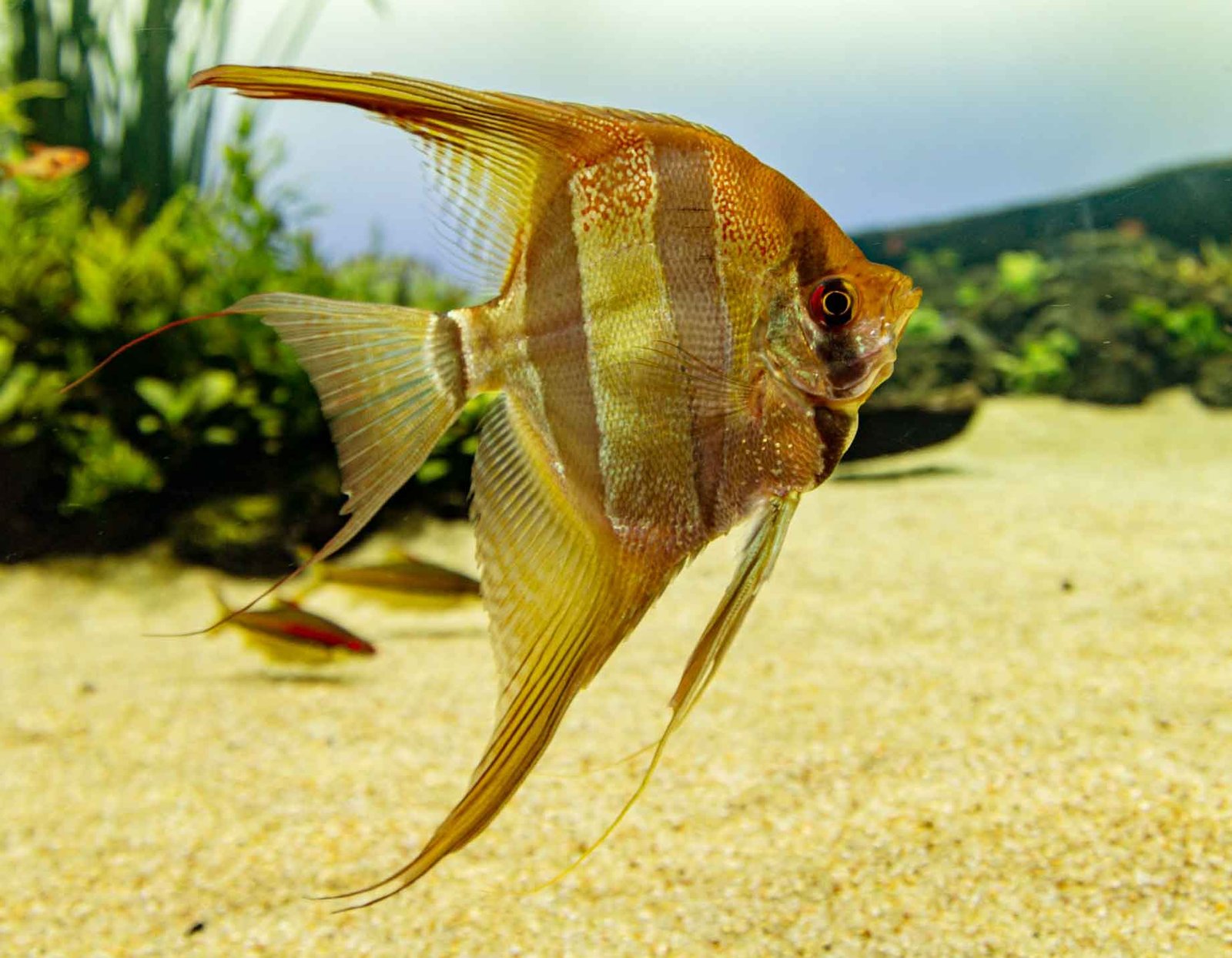
Angelfish
Behavioral Differences
- Betta Fish: Betta fish are small in size but are not peaceful and are very territorial in nature.
- Angelfish: Although angelfish appear peaceful, they can be large in size and sometimes territorial. They may prey on slow-moving fish or smaller fish.
Size Difference:
- Betta Fish: Betta fish are usually 2.5–3 inches (6–7.5 cm) long.
- Angelfish: Angelfish are larger, usually up to 6 inches (15 cm) long. Angelfish are much larger and stronger than betta fish, which can be dangerous for betta fish.
Water Parameter Differences:
- Betta Fish: Betta fish require warm water (24–28°C or 75–82°F) and a calm environment.
- Angelfish: Angelfish also prefer warm water, but they prefer more space and a dynamic environment than betta fish.
2. Fantail Goldfish

Fantail Goldfish
Differences in Water Environment:
- Betta Fish: Warm water fish. They require water temperatures of 24–30°C (75–86°F) and soft to moderately hard water.
- Fantail Goldfish: Cold water fish. They require water temperatures of 18–22°C (64–72°F) and moderately hard to hard water.
- The water temperature and hardness requirements of these two fish are completely different, so it is not possible to create a suitable environment for them in the same tank.
Behavioral Differences:
- Betta Fish: They are solitary and aggressive fish, especially towards other Bettas or brightly colored fish. They may bite the fins of slower-moving fish.
- Fantail Goldfish: They are peaceful and slow-moving fish. Fantail Goldfish may be injured or stressed by the Betta’s aggressive behavior.
Differences in Diet:
- Betta Fish: They require a high-protein diet (such as live or frozen food).
- Fantail Goldfish: They require mainly plant-based foods and some protein.
- It is difficult to meet their food needs in the same tank, and the high-protein diet of the Betta can be harmful to the Goldfish.
Tank Size and Design:
- Betta Fish: They can be kept in small tanks (at least 5–10 gallons), but the water quality must be maintained.
- Fantail Goldfish: They require a large tank (at least 20–30 gallons), as they grow quickly and produce a lot of waste.
3. Green Spotted Puffer Fish

Green spotted puffer fish
Behavioral Problems:
- Betta Fish: Betta fish are peaceful but territorial.
- Green Spotted Puffer Fish: These fish are aggressive and predatory in nature. They may bite the fins of the Betta or injure them.
Water Requirements:
- Betta Fish: Betta fish are freshwater fish and they prefer soft, slightly acidic to neutral water (pH 6.5–7.5). They prefer high temperatures (24–28°C).
- Green Spotted Puffer Fish: These fish initially live in freshwater, but as they grow older they require brackish or saltwater. They prefer high pH (7.5–8.5) and salty water. This environment is not compatible with Betta.
Diet:
- Betta Fish: Betta fish are mainly carnivorous and will eat flake food, live or frozen food (such as bloodworms, and brine shrimp).
- Green Spotted Puffer Fish: These fish prefer hard-shelled foods (such as snails, and crustaceans). They will not eat Betta food and may compete with Betta for food.
Habitat Differences:
- Betta Fish: Betta fish prefer slow-moving water and need plenty of plants and hiding places.
- Green Spotted Puffer Fish: These fish are active and prefer open swimming areas. They can disrupt the peaceful environment of Betta.
4. Tiger Barb

Tiger-barb
Aggressive Behavior of Tiger Barb:
- Tiger Barbs are semi-aggressive fish. They often bite the fins of other fish, especially those that are slow-moving or have long fins. The long and beautiful fins of Betta Fish can become attractive targets for Tiger Barbs.
- Betta Fish prefer to be quiet and solitary, and the disturbance of Tiger Barbs can stress the Betta.
Incompatibility of Tank Environment:
- Tiger Barbs prefer to be in groups and should be kept in groups of at least 5–6. This gregarious behavior can cause problems for Betta Fish, as Betta Fish prefers to be alone.
- Tiger Barbs swim fast and take up all the space in the tank, which can be stressful for Betta Fish.
Health Risks of Betta Fish:
- The aggressive behavior of Tiger Barbs can damage the fins of Betta Fish, which can lead to infection.
- When Betta Fish are stressed, their immune system decreases, and they can be affected by various diseases.
Lack of Proper Tank Environment:
- Betta Fish require calm and still water, whereas Tiger Barbs swim fast and create turbulence in the water.
5. Red Tail Shark

Red Tail Shark
Behavioral Incompatibility:
- Red Tail Sharks are semi-aggressive and territorial fish. They stay at the bottom of the tank and can be very aggressive in defending their territory.
- They may attack slow-moving fish or fish with long fins, such as Betta.
- They are slow swimmers and have long fins, which can be easy targets for other aggressive fish.
Difference in Environmental Needs:
- Red Tail Sharks prefer large tanks (at least 55 gallons) and moderate water flow.
- They are much more active than Bettas and can disrupt the Betta’s peaceful environment.
Aggressive Behavior:
- Red Tail Sharks may view the Betta’s bright colors and long fins as a target for attack.
- Although Betta fish are aggressive, they are not as strong as the Red Tail Shark, which can cause the Betta to become injured or stressed.
Conflict Over Tank Space:
- Betta fish usually stay at the top of the tank, while the Red Tail Shark stays at the bottom. However, the Red Tail Shark can be aggressive throughout the tank to defend its territory, which is dangerous for the Betta.
Stress and Illness:
- Keeping a Betta and a Red Tail Shark together can cause stress to both fish, which can lower their immunity and increase their risk of illness.


